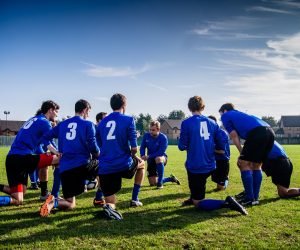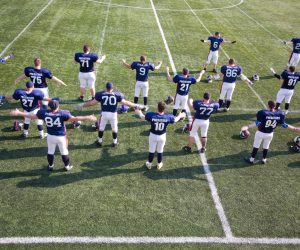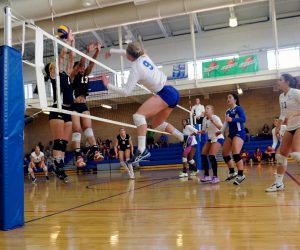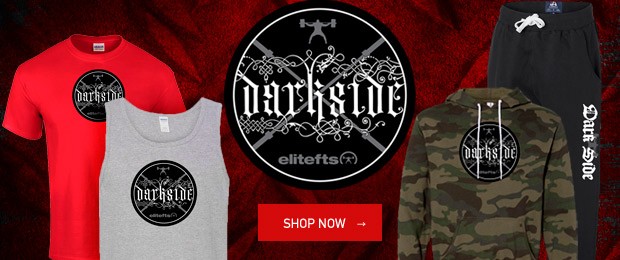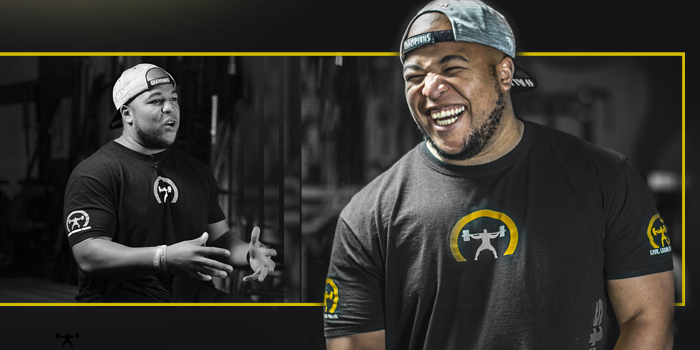
This article is probably long overdue from my side of the training perspective. As you all know, I tend to write more about leadership and about the mental side of sports versus the physical, but I felt this was a great topic to touch base on. Especially with opening day only a few days away (at the time I’m writing this article), I thought it was the perfect topic to kick it off with. This topic has been reshaped and rehashed thousands of times on the Internet, but I believe this will be a nice blend of the old and the new. So, sit back, and enjoy.
I wanted to write an article that impacts all of the sport teams I work with but can be used across really any team setting. This is going to be a general guideline I use for my entire program. The first thing I want to stress (and a huge area of my own personal growth as a coach) has been the realization that training the mental is so much more important than training the physical. This is something we all know, but how deep we get into training our minds varies by level of experience. As a young coach, I may have dropped a set or cut back on reps when I noticed that guys were fatigued in season. Other times, I kept pushing. The problem is that I never looked too deeply (nor did I care) about my athletes’ mental fatigue, and more so what the cause of this was. I am very lucky in my current job to have access not only to tendo units that monitor CNS fatigue but also to assistants who have taught me the importance of wellness surveys. I use both to help me to assess my athletes’ mental fatigue.
RECENT: The First Eight Months
We know that any stress is stress to the CNS to varying degrees. With that in mind, I take full advantage of the tendo units to “safeguard’ our fatigue. In season, we do every main lift based off of velocity zones. My heavier days are based on a .5 - .75 zone. I stress to my athletes that maxes from November are irrelevant. Percentages don’t take into account the stress of fighting for a starting position, a bad game, homework, or whatever the case may be. So, with that in mind, we go off of how efficiently the CNS is firing at that time. The percentages are our guidelines, but the zones are our roadmaps. I have really changed my mindset regarding in-season training to a more optimal sense than a maximal one. If we are moving the same weights faster, than we are becoming more powerful in-season. Which is really the key. Never do I want to get weaker in-season, but on the same token, I don’t want to get less powerful.
I also stress mental skill training. I want to preface this statement by saying that I am not a sport psychologist by any means. But luckily, we have many who work with our athletes. Just as most of us will sometimes use sport references gained from listening to sport coaches when making an analogy, I do the same with mental skill discussions. I sit and talk with our sport psychologist to use his terms or his messages in our end-of-lift discussions. I will talk about mental imagery, or focus through chaos, or whatever the case may be with my athletes. I would be remiss if I didn’t share the knowledge I have gained with my athletes in attempts to better them not only on the field but also in life. A thing that really gets overlooked in-season is “how are we doing mentally.” I try the best I can to constantly check in on this. Not with rah, rah clichés but with actual tools I’ve acquired. But it’s also just as simple as having constant conversations with my athletes to see how they are really doing outside of sports. Sometimes what they need is someone who cares outside of performance, so be that person.
Now from an X’s and O’s standpoint, I always look at the biggest bang for my buck. Exercise selection matters, but executing the right exercises the wrong way is extremely detrimental. Toward the beginning of the season, we will keep full range of motion (ROM) on main lifts, but as the season progresses, we will start to cut ROM and increase our pre-hab/mobility type of exercises. If I’m going to cut ROM somewhere, I’ll get it back somewhere else. This could look like cutting a conventional deadlift to a trap bar deadlift to a pin deadlift, but doing a heels elevated deep squat stretch and working in hip flexor stretches or some other form of mobility exercise. I never want to sacrifice mobility. I also don’t believe that you have to lift heavy through extreme ROMs in-season to maintain mobility. If you’ve done your work in the off-season, you will be fine in-season.
MORE: The Specific Demands and Application of Conditioning for Sports
From a conditioning standpoint, I don’t condition my athletes in-season. By the time pre-season is over, conditioning should be coming entirely from the sport of play. But what we don’t usually get out of sports (especially field sports) is the speed component. This is where I like to slip it into my warm-up. The team’s warm-up ends with 100% acceleration. Now this doesn’t seem like much, but they do our warm-up seven times per week minimum. So, I get 70 yards of 100% acceleration work in minimum throughout a week. I feel comfortable with this number in terms of our still maintaining that “first step” speed. And I know that’s not the most scientific-sounding statement, but this is my article, so feel free to disagree, or write your own. When it comes to the in-season, a major reason I don’t condition athletes is because again it should be coming from practice, and I only have so much stress to pull from them within a week. I don’t feel the need to pull any more than I need to, and to me, conditioning in-season is a useless waste of pulling out a stressor.
From a nutritional standpoint/recovery standpoint, we try to have our hands on this as much as possible. I will go over nutrition first. We pick meals on the road and try to control what is being given to our athletes as much as possible to fuel their performance. We also educate our athletes on feeding themselves for performance versus just eating because they’re hungry. We stress what inflammatory responses some food choices have, and we guide them in making smarter choices in alignment with their performance goals. We all love Big Macs, but after a four-hour baseball game, this might not be the best option. We partner with our sport coaches to make the best decisions about pre- and post-game meals, as well as what we give them for fuel before, during, and after a game. This has been a big help for our athletes, and we continue to see a lot of success in this area.
Along with nutrition (or hand-in-hand with nutrition), we stress the importance of recovery. First and foremost, this starts with sleep and hydration. A dehydrated, non-rested athlete is an injury waiting to happen. We talk to our athletes about the importance of sleep and how to achieve more restful sleep. We also talk about hydration requirements/timing and how to avoid bad situations when it comes to hydration, on top of the effects that poor hydration has on performance. We also give our athletes access to a vast number of recovery tools/modalities between us and athletic training. I think a big thing to remember is that there is no one-size-fits-all. If I feel more stressed being forced into a cold tub, then maybe it’s either because I’m not educated on it or because I truly just don’t like it. If the modality brings about unnecessary stress, it’s not an effective recovery modality. Me personally, I loved the cold tub in-season. Science behind that didn’t matter—it made me feel better. Now that doesn’t mean that I used the cold tub only. I rolled, stretched, massaged, and used many other tools to help me to feel better during the season. But the key is, I used modalities that helped me to feel better, not ones that made me feel more uneasy. Providing proper recovery for your athletes can be summed up as finding what works for them and being consistent about it. Stress to your athletes that they need to be active in taking care of their bodies before a small issue becomes a major problem. Have multiple tools for your athletes to use because, again, one size does not fit all.
These are just a few of the main considerations I think about for in-season teams. I hope that this article has shed light on a few new modalities but has also stressed the importance of tried-and-true methods. This wasn’t meant to be a philosophical debate about programming. When it comes to programming, do what works for your athletes. Some people reject conjugate during the season. For my athletes, we have found great success when continuing to use conjugate methods in-season. I scale back on the exercise rotation, but my method for selecting our next set of new exercises is beyond the scope of this article. Whatever you do, constantly inspect it, and see what works. Also, note that maintaining open lines of communication with your athletes can help programming tremendously. What looks good on paper and what works in practical applications are often two completely different things.











